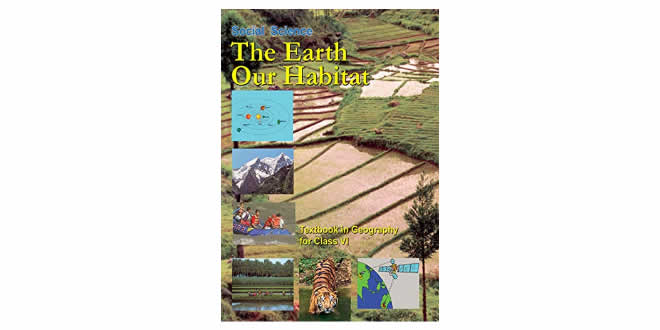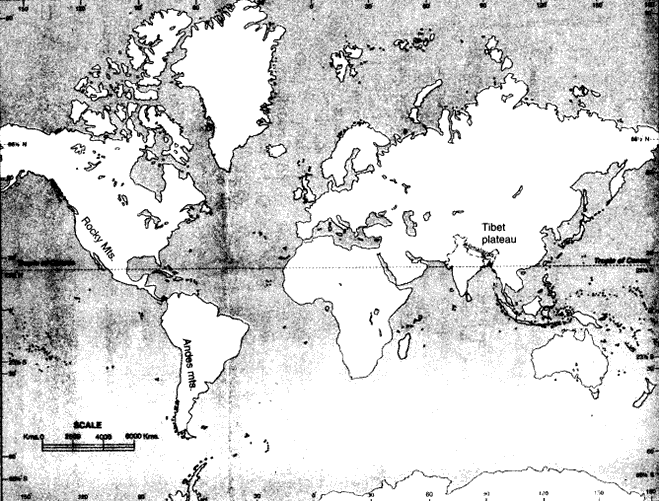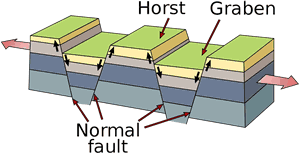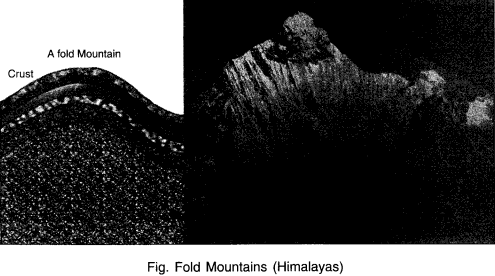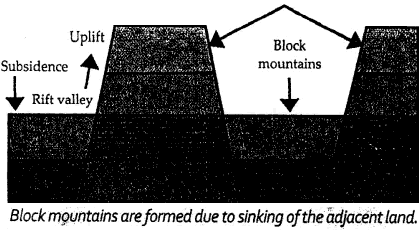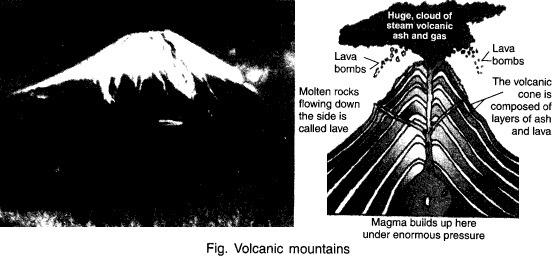Major Landforms of the Earth – 6th Class NCERT CBSE Social Science (Geography) Chapter 06
Question: Answer the following questions briefly.
- What are the major landforms?
- What is the difference between a mountain and a plateau?
- What are the different types of mountains?
- How are mountains useful to man?
- How are plains formed?
- Why are the river plains thickly populated?
- Why are mountains thinly populated?
Answer:
- The major landforms are – mountains, plateaus and plains.
- A mountain may have a small summit and a broad base. But a plateau is flat-topped table standing above the surrounding area.
Example of mountain: The Himalayan mountains.
Example of plateau: The Deccan plateau. - Mountains are of three types:
(i) Fold mountains
(ii) Block mountains
(iii) Volcanic mountains - Mountains are useful to man in a variety of ways:
(i) Mountains are storehouse of water which is the basic need of the human beings. Reservoirs are made and the water is harnessed for the use of people. Water is used for irrigation and generation of hydroelectricity.
(ii) Mountains have a rich variety of flora and fauna.
(iii) Mountains provide an idyllic site for tourists. They visit the mountains for their scenic beauty. - Plains are generally formed by rivers and their tributaries. The rivers flow down the slopes of mountains and erode them. They carry forward the eroded material. Then they deposit their load consisting of stones, sand and silt along their courses and in their valleys. It is from these deposits that plains are formed.
- The river plains are very suitable for human habitation. People get flat land for building houses and for cultivation. The soil of river plains is very fertile. Hence people live here and cultivate land for their living.
- Life is very difficult in mountain areas because of harsh climate. It is quite difficult to grow crops, build houses or roads in a mountain. Hence, people do not prefer to live here.
Major Landforms of the Earth – Question: Tick the correct answer:
- The mountains differ from the hills in terms of
(i) elevation (ii) slope (iii) aspect - Glaciers are found in
(i) the mountains (ii) the plains (iii) the plateaus - The Deccan plateau is located in
(i) Kenya (ii) Australia (iii) India - The river Yangtze flows in
(i) South America (ii) Australia (iii) China - An important mountain range of Europe is
(i) the Andes (ii) the Alps (iii) the Rockies
Answer:
- (i)
- (i)
- (iii)
- (iii)
- (ii)
Major Landforms of the Earth – Question: Fill in the blanks:
- A ………… is an unbroken flat or a low-level land.
- The Himalayas and the Alps are examples of ………… types of mountains.
- ……… areas are rich in mineral deposits.
- The …… is a line of mountains.
- The ……….. areas are most producing for farming.
Answer:
- plain
- young fold
- Plateau
- range
- plain
Question: What kind of landforms are found in your state? Based on the reading of this chapter, say how they are of use to the people.
Answer: Plains are found in my state. Plains are generally very fertile. Hence, people can easily engage themselves in farming activities and get high produce. As the land is plain and level, construction of transport network is very easy. Construction of houses is also carried on large scale. Thus, plains provide all facilities for human habitation. Perhaps therefore, thick population is found here.
Multiple Choice Questions
Question: Choose the correct option to complete the sentences given below:
- It is the mountain range of South America
(a) The Himalayas (b) The Alps
(c) The Andes (d) The Rockies - Mt. Kilimanjaro is in
(a) Asia (b) Africa
(c) South America (d) North America - Which one sport is not popular in the mountains?
(a) Paragliding (b) Skiing
(c) Hang gliding (d) Football - The Hundru falls is in
(a) Chhota Nagpur (b) Calcutta
(c) Ranchi (d) Chhattisgarh - The world’s highest plateau is the
(a) Deccan plateau (b) Tibet plateau
(c) Chhota Nagpur plateau (d) East African plateau
Answer:
- (c)
- (b)
- (d)
- (a)
- (b)
Fill in the Blanks
Question: Fill in the blanks with appropriate words to complete each sentence:
- Many of the mining areas in the world are located in …………….. areas.
- The climate of mountains is …………………..
- Mountains vary in their ……………….. and shape.
- The Ural mountains in …………….. have rounded features and low elevation.
- Volcanic mountains are formed due to …………………… activities.
- The …………. and terraces are ideal for crop cultivation.
- ………… in the Pacific Ocean is an undersea mountain.
Answer:
- plateau
- harsh
- heights
- Russia
- volcanic
- river basins
- Mauna Kea (Hawaii)
True / False: Major Landforms of the Earth
Question: State whether these sentences are true (T) or false (F).
- A rich variety of flora and fauna is found in the mountains.
- The Rope Bridge is in Arunachal Pradesh.
- Plateaus are vast stretches of flat land.
- Plains are very useful because they are rich in mineral deposits.
- As we go higher, the climate becomes hotter.
- Mt. Fujiyama in Japan is an example of volcanic mountains.
- It is difficult to carry on construction work in plains.
Answer:
- True
- True
- False
- False
- False
- True
- False
Matching Skill
Question: Match the items in column A correctly with those given in column B.
(ii) The Vosges mountain
(iii) The Aravali range
(iv) The East African plateau
(v) The Jog falls
(b) India
(c) Karnataka
(d) Europe
(e) North America
Answer:
- (e)
- (d)
- (b)
- (a)
- (c)
Question: What is internal process?
Answer: It is a type of continuous movement within the earth that lead to the upliftment and sinking of the earth’s surface at several places.
Question: What is external process?
Answer: It is the continuous wearing down and rebuilding of the land surface.
Question: What is called erosion?
Answer: The wearing away of the earth’s surface is called erosion.
Question: What happens when you go higher?
Answer: The Climate becomes colder.
Question: Give examples of young fold mountains.
Answer: The Himalayan Mountains and the Alps.
Question: What are the features of young fold mountains?
Answer: They have rugged relief and high conical peaks.
Question: What is special with Mauna Kea (Hawaii) in the Pacific Ocean?
Answer: It is higher than Mt. Everest being 10,205 metres high.
Question: Give an example of block mountains.
Answer: The Rhine valley and the Vosges mountain in Europe.
Question: Give examples of Volcanic mountains.
Answer: Mt. Kilimanjaro in Africa and Mt. Fujiyama in Japan.
Question: Name the plateau which is famous for gold and diamond mining.
Answer: The African plateau.
Question: Name some plains of India.
Answer: The Ganga-Brahmaputra plains and the Indo-Gangetic plains.
Question: Write some natural calamities.
Answer: Earthquakes, floods, cyclone, drought etc.
Question: ‘Quite often we use the land in a wasteful manner’. What do you mean by ‘wasteful manner’?
Answer: Using fertile land for building houses.
Short Answer Type Questions: Major Landforms of the Earth
Question: Write a few features of mountains.
Answer:
- Mountains are natural elevations of the earth’s surface.
- They are higher than the surrounding area.
- Some of them are even higher than the clouds.
- The climate of mountains is harsh, which makes them less suitable for human habitation.
- Mountains have steep slopes. Hence, farming is quite difficult here.
Question: What are block mountains?
Answer: Block mountains are created when large areas are broken and displaced vertically. The uplifted blocks are known as horsts and the lowered blocks are known as graben. Examples: The Rhine valley and the Vosges mountain in Europe.
Question: How are plateaus useful for man?
Answer: Plateaus are very useful for man because they have rich mineral deposits. Many of the mining areas in the world are located in the plateau regions. For example, the African plateau is famous for gold and diamond mining. The Chhota Nagpur plateau in India has huge reserves of iron, coal and manganese. In the plateau regions, one can find several waterfalls. Many plateaus have scenic spots which attract tourist on large scale.
Question: What are the features of plateaus?
Answer:
- Plateaus are elevated flat lands. It is a flat topped table land standing above the surrounding area.
- Plateaus have one or more sides with steep slopes.
- Their height often varies from few hundred metres to several thousand metres.
- Plateaus may be young or old. The Deccan plateau in India is one of the oldest plateaus.
- The Tibet plateau is the highest plateau in the world.
- Plateaus are storehouse of minerals like gold, diamond, iron, coal etc.
Major Landforms of the Earth – Question: What are the features of plains?
Answer:
- Plains are vast stretches of flat land.
- Some plains are extremely level. Others may be slightly rolling and undulating.
- Plains are usually fertile regions. They are suitable for cultivation.
- They are usually thickly populated regions.
- It is easy to build houses, roads etc. in plains.
Question: What are the major landforms? Write about them in brief
Answer: The major landforms are mountains, plateaus and plains.
- Mountains: They are natural elevation of the earth surface. They are higher than the surrounding area. Some mountains are very high. They are even higher than the clouds. Some mountains have permanently frozen rivers of ice known as glaciers. Mountains are generally thinly populated regions because the climate is harsh there. Farming is also not easily possible there. But mountains provide us water. They have a rich variety of flora and fauna.
- Plateaus: They are usually flat-topped table land and are higher than the surrounding area. Plateaus may be young or old. The Deccan plateau in India is one of the oldest plateaus. Plateaus are very useful for mankind. They have rich deposits of minerals such as diamond, gold, iron, manganese etc. Several water falls can be found in the plateau regions.
- Plains: They are vast stretches of flat land. They are mostly formed by rivers and their tributaries. Plains are usually fertile lands. Hence, thick population is found there. Construction of transport network is easy. Cultivation is also easy. Plains also provide level land for the construction of houses or buildings. In India, the Indo-Gangetic plains are the regions where one can find great concentration of population.
Major Landforms of the Earth – Question: How many types of mountains are there? Write briefly about each of them with help of diagrams.
Answer: Mountains are of three types:
- Fold Mountains
- Block Mountains and
- Volcanic Mountains
1. Fold Mountains: The Himalayan Mountains and the Alps are young fold mountains. They have rugged relief and high conical peaks. The Aravalli range is India is one of the oldest fold mountain systems in the world. The Appalachians in the North America and the Ural mountains in Russia are vary old fold mountains.
2. Block Mountains: These are created when large areas are broken and displaced vertically. The Uplifted blocks are known as horsts and the lowered blocks are called graben. The Rhine valley and the Vosges mountains in Europe are examples of such mountain systems.
3.Volcanic Mountains: They are formed by volcanic activity. Mt. Kilimanjaro in Africa and Mt. Fujiyama in Japan are examples of such mountains.
 Class Notes NCERT Solutions for CBSE Students
Class Notes NCERT Solutions for CBSE Students
